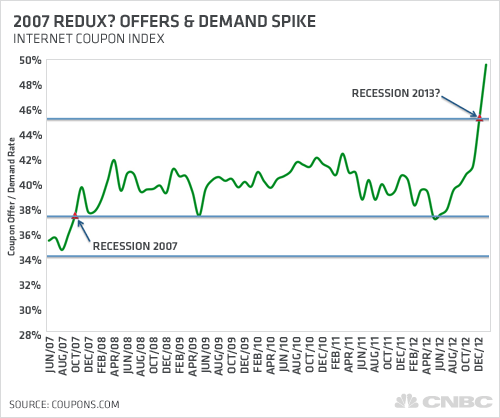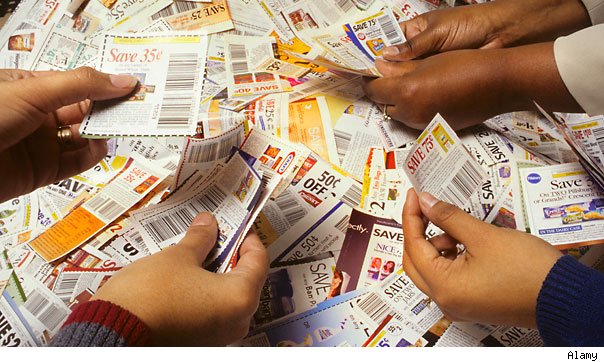When the economy sinks deeper, consumers tend to get creative about finding ways to cut on spending.
Equipped with scissors, printers and shopping carts, in recent years many Americans have hunted for online coupons to save on products like canned soup, toothpaste and cookies.
While consumers print and clip their coupons,  economists closely watch their activity, trying to link it to economic growth or decline.
economists closely watch their activity, trying to link it to economic growth or decline.
Over the years, they have calculated that the more people print coupons, the worse the economic pressure they are feeling.
Originally intended as a form of advertising, coupons became a way for some customers to increase the value of their non-monetary exchange for groceries and goods.
It also became an economic indicator of how well the economy is doing, creating a phenomenon called the “Coupon Index.”
Websites such as Coupons.com track the frequency with which people download and print coupons. This shows an increase or decline in coupon users’ activity, and as a result in the consumers’ intend to save more money.
During times of economic hardship, the discounts become a reliable source for many to save money. Advertisements have transformed into ways to save and get the products for “couponers,” as they call themselves.
“The index tends to run in a range,” Steven Boal, a CEO at Coupons.com said in an interview with CNBC. “In September, October, November in 2007, it popped out of its range for the first time.”
Boal said he believes coupons represent a useful indicator of shopper behavior and economic activity because “you don’t need months of data to see consumer behavior patterns emerge.”
A few years ago during the peak of economic decline, coupon redemption topped 3.3 billion while shoppers sought the way to save on groceries and goods, according to Business Insider.
“The higher the index value, the more consumers are under economic pressure,” Boal said.
In 2010, the volume of coupons increased significantly rose to more than 178 billion coupons, making it up to 570 coupons for each American, according to Forbes.
Last year, the Consumer Packaged Goods issued 315 billion coupons — 993 coupons for each American, a 3.3% rise from a previous year, according to NCH.
Still, since the economy started recovering, the coupon’s redemption rate and demand has lowered since 2013 from 2.9 billion to 2.8 billion coupons to a prior year.
Stores such as Wal-Mart, Target, Walgreens and CVS are among the top ten stores that made it to the list of top 10 retail coupon redeemers in 2013 with M&Ms, pasta, rice and cheese as most popular products, according to the Coupon.com.
Coupons vary, depending on the type of product they advertise — food, goods or cosmetics.
As the economy started recovering, the market started to shift to the non-groceries related segment, which is normally in a lower demand and requires more time for redemption.
Of course, what has yet to be examined is the amount of time people spend finding and clipping coupons, and then planning their purchases to align with whatever’s on sale. If people are spending more time “couponing” than at work, or looking for a job, then perhaps the whole idea is more of a distracting advertising scheme than a true way to save money.


Leave a Reply
You must be logged in to post a comment.